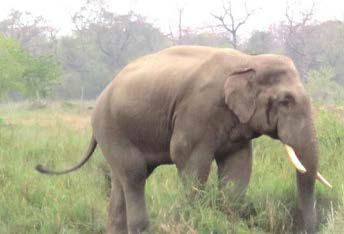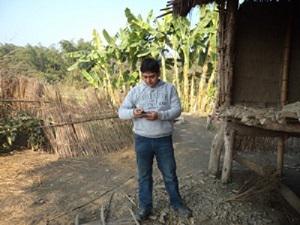Ganesh Pant
The project aims to analyse human-elephant conflict and explore strategies to minimize conflict so as to ensure human-elephant coexistence in Central Nepal. In addition, the project will raise public awareness on elephant conservation.

Problem Elephant Dhurbe. This 30-35 years old tusker has already killed more than 10 people around Chitwan National Park and Parsa Wildlife Reserve.
Asian elephant is a key biological species in the tropical forests of Asia. The species is listed in Appendix-1 of CITES, categorized as endangered in IUCN Red Data Book and protected under National Parks and Wildlife Conservation Act, 1973 in Nepal. There is a remnant population of less than 150 wild elephants in Nepal at present distributed in four isolated forest habitats. In central Nepal, an estimated population of 25 to 30 elephants is largely resident within Parsa Wildlife Reserve and Chitwan National Park (DNPWC 2008).

Field Assistant Mr. Khemraj Adhikari conducting household questionnaire survey.
However, occasional hostile interaction between wild elephants and local people is considered as common phenomenon, human-elephant conflict has suddenly increased in Central Nepal. The severity of the problem is reflected by the fact that wild elephant killed 10 people in and around Chitwan National Park last year (CNP 2011). If the situation continues, it will not only intensify vulnerability to the people living around protected areas but also jeopardize the survival of this endangered species. Thus, this is a serious concern and needs immediate management intervention for securing the well being of both human and elephant in this human dominated landscape.
It is realized that increased level of hostile interactions between wild elephant and local people is one of the big challenges for elephant conservation in Nepal. But the causes of sudden rise in human-elephant conflict are not adequately understood. In this context, the proposed project will systematically analyse the issues associated with human-elephant interface around Chitwan National Park and Parsa Wildlife Reserve. Household Questionnaire survey, key informant interview and field observation are the methods planned to use in collecting primary data. Secondary data will be collected from the office records of Chitwan National Park and Buffer Zone User Committees as well as from the relevant literatures.
The project will assess the spatial and temporal distribution of the crop damage and human casualty by wild elephant in Central Nepal, identify major causes of human-elephant conflict in this landscape and help to understand local people’s perception on human-elephant conflict, effectiveness of preventive and mitigation measures and elephant conservation. Based on the findings of the study, the project will devise both immediate and long-term strategies that are needed for management intervention to minimize human-elephant conflict. The other important component of the project is to raise public awareness for elephant conservation through interaction meetings and school programs in the clusters, which are highly affected by wild elephants.